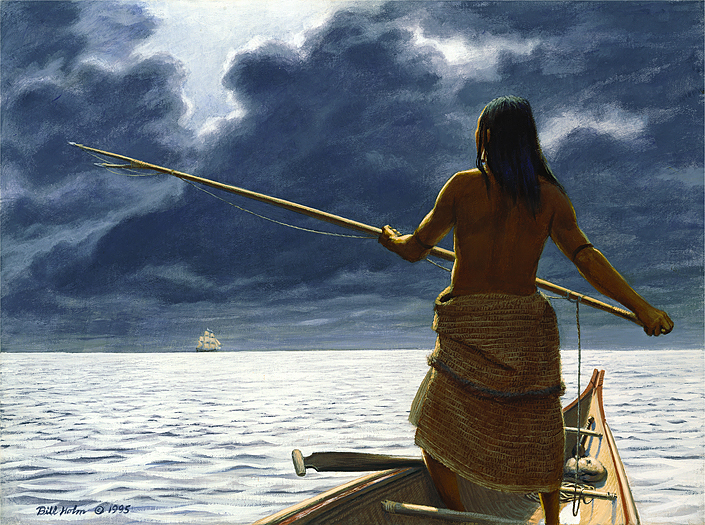First Sail
EXHIBITION:
Winter 2020A Mowachaht seal hunter is surprised to see on the horizon the first European ship to approach Vancouver Island. The Spanish frigate Santiago, Captain Juan Perez, was returning to Mexico from a voyage to Alaska, undertaken primarily to ascertain the extent of the Russian presence on the Northwest Coast. On the way north, Perez had met and traded with Haida Indians at the northwestern tip of the Queen Charlotte Islands, apparently the first contact that those people had with Europeans. A few objects now in the Museo de America in Madrid (among them a beautiful ivory bird amulet) form the earliest collection known from the Northwest Coast.
On August 8, 1774, on the way south, the Santiago approached the west coast of Vancouver Island and anchored in the vicinity of the entrance to Nootka Sound. Mowachaht canoes gathered around the ship, and again the Spanish seamen traded for artifacts from the Indians. A boat sent shoreward with a wooden cross, intended to mark the spot where the ceremony of possession was to take place, was forced to return to the ship when the weather changed for the worse. This fleeting contact was the basis on which the Spanish claimed sovereignty in the area, and it was the first meeting of Nuu-chah-nulth (Nootkan) people with white men, whose ships, following Captain James Cook’s anchorage in Nootka Sound four years later, came in increasing numbers until the end of the sea otter trade.
The hunter holds his long seal harpoon, ready to make the cast. Its double prongs are armed with barbed points that detach from the harpoon on striking the quarry. A line of braided sea lion gut runs from the points, through a retaining loop on the shaft, to a float made of an inflated seal stomach or to a thwart of the canoe. When the seal is brought to the canoe, the hunter kills it with a wooden club, here propped in the bow. His robe of shredded yellow cedar bark, twined with nettle-fiber cord, is belted at the waist. To free his arms for the cast, the robe’s upper part, with its sea otter fur-wrapped headline, is folded down. It was this fur that drew the flotillas of trading ships to the Northwest Coast in the waning years of the century.
Sun Dogs and Eagle Down: The Indian Paintings of Bill Holm by Steven C. Brown, with a chronology and bibliography by Lloyd J. Averill and with captions by Bill Holm; p.154

